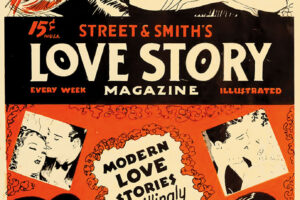Ed Hulse, Barry Traylor and Walker Martin made some good points in their comments to my “Future of the pulps” entry a few weeks back.
Certainly, there is something intrinsically fulfulling when you hold a pulp magazine. You hold a bit of history in your hands, knowing that it was purchased off some magazine stand a half-century or more ago. Knowing that someone likely bought it for the excitment depicted on its cover and detailed inside.
The collecting of physical pulp magazines shouldn’t — and won’t — go away.

Agreed, there are pulps in fine to near-pristine condition.
But I would wager that the vast majority of pulp magazines aren’t in that condition. And, more than likely, not every number of every pulp title could be found in such condition. This may be more likely for those less-desirable titles – less desirable because they don’t include the better fictioneers or illustrators.
The point I was trying to make the last time was that it’s time for us, the pulp community, to start thinking about long-term preservation of pulp fiction. The magazines are here today, but what about 50 or 100 years from now?
I would hate to find out that stories by only the key fictioneers or featuring the most popular characters are all that survive from this significant, but largely ignored, period of America’s literary heritage.
Last time, I mentioned the Pulp Scans group at Yahoo, a collection of pulp fans that has been scanning mostly science fiction pulps the past few years. They’ve done an admirable job with their limited resources.
What is needed, though, is something on the scale of Google’s book scanning efforts. Something organized and well planned, so it isn’t haphazard.
The drawback of that is cost. Both in acquiring the pulp magazines to scan and the actual equipment and scanning.
How could that be financial mountain be overcome? Would some sort of nonprofit organization — say, a Foundation for American Popular Fiction of the 20th Century — be the way to go?
It would be a shame if the vast majority of true pulp fiction disappeared in the years to come. What should we do?
– William



Funny you should mention it, William: I have taken some tentative steps toward the establishment of just such an entity as you propose, and it has a similar name: the Institute of American Popular Fiction. I would opt to archive all forms of popular-priced, mass-market literature dating back to the story papers of the mid-19th century and including dime novels, nickel weeklies, slicks with large quantities of fiction, and paperback originals as well as pulps. I don’t know how far it’ll get, and I hadn’t planned on mentioning this project before getting more information, but it’s nice to know that others are thinking along the same lines. It would be great to have such an institution — one of which future historians could avail themselves when researching the evolution of American popular culture.
Hot diggety dog — this is progress! I would imagine that the problem isn’t going to be finding the pulps. It’s going to be finding the manpower (and womanpower) to scan and archive them on a continuing basis and maintaining the site. But with a non-profit status you can apply for $ to get the warm bodies to do the work. I imagine some kind of organized system should be in place to get this off the ground, and ED is just the person to do it!
I think the pulps should be offered in a digital format for consumption, but as a supplementary means of enjoying these books, not to replace the experience of holding the real thing. It isn’t an either/or situation. If you do not want to read your pulps on a “gizmo” (a facile and dismissive term, by the way), well, nobody’s forcing you to. For what it’s worth, I would jump at the opportunity to buy a digital issue of my favourite Weird Tales or Shadow to be viewed on whatever media device I’m using.
If it’s rendered in a reasonably realistic way to approximate the look of the real cover and inside pages, then why not? I’d rather take that digital copy on an eight-hour flight than my eighty-year-old original.
Again, I don’t think this method of consumption should replace the real artefact. It’s just another way to enjoy these wonderful and vital pieces of literary history.
[…] Yellowed Perils Thoughts and Comments on the World of the Pulp Magazines « The future of pulps, part 2 […]